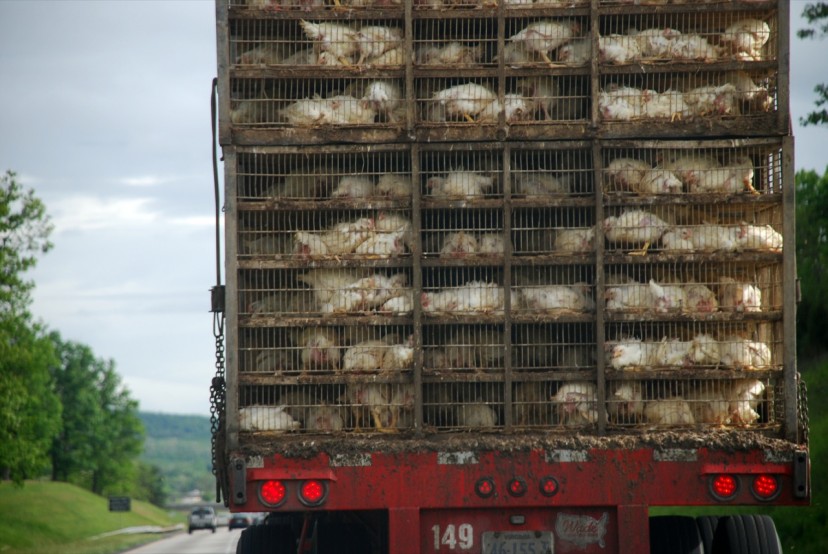Ever since American journalist, Upton Sinclair published the novel The Jungle highlighting the horrific conditions and unsanitary practices of the meatpacking industry during the 20th century, what happens in US factories and meat companies has been a topic high on the radar of society. Before 1906, little was known about the inner workings of food processing companies. Upton Sinclair changed that drastically. Now in 2015, journalists still uncover shocking stories and facts the meat industry executives are hiding from consumers.
More focus on manufacturing practices, additives, and food processing has occurred in recent decades, uncovering many reasons why the food system in the United States could use reform. Even all-natural, and some organic products that are labeled as such can still misguide consumers to thinking they are safe and healthy. These issues make it increasingly important to understand what exactly is going into the food placed on store shelves and on to your dinner table. Many misconceptions are believed to be true about the meat industry and the health of the products in grocery markets.
Here are five myths I have debunked to make sure that the meat that you choose is the best for you and your family.
1.) Grass-Fed Meats May Be Healthier For You: TRUE

Studies suggest that grass-fed products are richer in omega-3 fats and conjugated linoleic acid than those animals raised on grain products. Cows naturally eat grass diets, however many industrial farms use grain as feed to supplement their diet and increase growth potential. Not only do grass-fed animal products contain more nutrients than grain-raised, grass-fed products have less fat. This is one of the main reasons that industrial meat plants do not want to follow the grass-fed diet for their main production farming. This method produces less meat overall and would cut into the amount of production, creating less profit for the demand of meat. Lean meat has less calories and can help lower cholesterol; as well as increase important nutrients and fatty-acids which have been linked to reducing risks of cancer.
2.) Producing Meat Products is Sustainable for the Environment: FALSE
The meat industry is under heavy scrutiny for the environmental carbon footprint associated with production. According to the Washington Post, the U.S. Department of Agriculture will release their latest dietary guidelines for this year and they are suggesting eating less meat. Eating less meat has already been a trend throughout the United States due to healthier diet choices; the vegetarian diet reflects what is good for the environment as well. Studies from the Journal of Climatic Change show that the “average meat-eater in the U.S. is responsible for almost twice as much global warming as the average vegetarian.”
Not only do the U.S. Department of Agriculture recommendations reflect a healthier diet, but a sustainable one as well. Animal-based products take a lot of preparation for consumption; even preparation of small amounts for consumption take a staggering amount of water, land, food, and energy. Allison Aubrey and Dan Charles from the Morning Edition of NPR reported on what goes into one quarter-pound of hamburger meat. Check out the story here.
Even though Americans don’t necessarily take heed in the dietary recommendations made by the U.S. government, it does influence the amount of meat available in school lunch programs, and other important guidelines that structure meat-purchasing programs. The bottom line is that less meat consumption overall is better for the environment, regardless of the direct health factors associated with the human body.
3.) Eating “Natural” Meat Products Reduce Risk of Antibiotic or Hormone Exposure: FALSE
Understanding labels placed on products is key to ensuring that food is safe for consumption and doesn’t include harmful antibiotics. The term “natural” is often confused with “naturally raised” and they mean two very different things. “Natural” relates to no additives or preservative being added after the meat or poultry is processed. However, this does not include the conditions that they were raised under. “Naturally Raised,” according to the USDA, means that the animal was not given antibiotics, growth hormones or animal by-products during the raising of the animal. The use of antibiotics and growth hormones is highly prevalent in chicken and beef in order to generate higher production and ward off disease. In 2012, John Hopkins University reported that traces of allergy medication, painkillers, antidepressants, and banned antibiotics were found in chicken products across the multi-state research study.
Make sure that labels are carefully checked when purchasing meat from the grocery store. Don’t always trust the happy farmer labels. Ensure that the label includes the term “USDA Certified Organic” which is determined by a certification program. Ask questions about what each label means and if looking for naturally raised products, go to a local farm market or direct to a farmer that you trust. Many local farms have the highest quality products, but cannot go through rigorous USDA Certified Organic labeling due to its high cost.
4.) Undercooking Meat is the Only Way to Get Sick: FALSE
Large processing plants can cause contamination and potential life threatening bacteria to enter the meat products and make you, the consumer, very sick. A study performed by the University of Iowa in 2012 reported that MRSA (methicillin-resistant Staphylococcus aureus bacteria) was found in high prevalence throughout retail pork products in the United States. MRSA is estimated to cause around 185,000 cases of food poisoning a year and can cause life-threatening infections. Buying meat products from the grocery store provides a significant risk to the consumer due to the high prevalence of staph. Contamination can happen during the processing stage through mixing of meat types or other improper handling measures. MRSA is hard to kill and has shown a significant resistance to many varieties of antibiotics. Buying from local farmers or farms that use smaller processors can reduce this risk of contamination.
Localharvest.org is a great resource to find local farmers that have their own slaughter methods or use smaller processors. Despite even some of the most cautious methods taken for proper cooking and handling of meat products, the incidence and risk of infection or illness is high. Make sure that you use these best meat handling and cooking practices to avoid cross contamination or illness.
5.) High Quality Steak is Safe: FALSE
Beef is often inherently tough due to farming practices and no one likes a tough, chewy piece of steak. In order to provide delicious tender cuts of beef, many slaughterhouses have adopted methods of mechanically tenderizing steaks and other high quality cuts of beef. This process includes driving blades and needles into the steak, which can cause bacteria present on the surface to be driven deep into the meat of the steak. During the cooking process, this bacteria would normally be seared off, however with a mechanically tenderized piece of beef, the bacteria often remains alive and inside the meat. If you are a person who likes your meat order rare or medium, the potential for sickness increases dramatically.
Food Safety News reports that many of the outbreaks of foodborne illness can be linked back to mechanically tenderized beef, including an outbreak in 2012 of E. Coli that resulted in the biggest recall in Canadian history. These procedures are not tracked by any regulations, and plants are not required to use a label to identify meat that has undergone tenderizing. There is no way to identify potentially contaminated products, so it’s very important to follow strict guidelines for meat preparation to ensure that consumers are fully aware of the potential risks and contamination prevalent in meat products.
In conclusion, I urge you to completely understand what is within the food you eat and not just turn a blind eye. Labeling standards are not consistent in many products. Even when labeled, consumers can easily misunderstand what they’re reading. With any meat product, proper handling and cooking techniques must be followed to ensure that the product is safe to eat. I recommend that it’s always best to go with organic, naturally raised meat products from a local farm that you trust. When that’s not possible, check the labels carefully at the market and ask questions to a knowledgeable associate or manager when unsure. The concerning truth is that even the products at the grocery store can be unsafe and therefore it is our responsibility to be educated and responsible for what is going into our own bodies!








